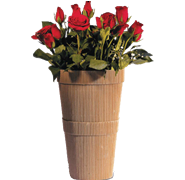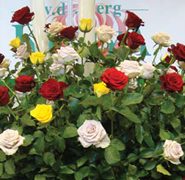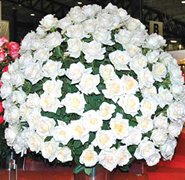Featured Past Articles
Focuses on Sustainability and Market Access Through a National Mechanism for Compliance
Kenya Flower Industry focuses on sustainability and market access through a national mechanism for compliance. To support the Kenya Flower Industry in assuring sustained access to international markets, Kenya Flower Council (KFC) held two successful meetings in the United Kingdom and in the Netherlands on 1st and 6th November 2014 respectively. The meetings focused on Kenya flower market sustainability and market access through a national mechanism for industrywide compliance.
Europe is a major destination for Kenyan flowers with a market share of over 35% and most of which are transhipped through Holland. The meetings offered a platform for the Kenya Industry to share ongoing sustainability initiatives with their international partners with an aim of strengthening market access and trade. Kenyan embassies both in the UK and the Netherlands played a big role in mobilizing partners in their respective location in effort to strengthen international trade which is now a key mandate under the Ministry Of Foreign Affairs. The NMC project was presented with a background on Kenya flower industry as a major foreign exchange earner contributing about 1.3% (46.3 billion) of the GDP and impacting about 2 million livehoods.
However, despite a myriad of both public and private tools governing regulation of the industry in the realm of labour standards and use, protection and stewardship of natural resources, it is clear from consistent reports and concerns raised in the public space, that more work on the robustness and thorough implementation of the regulatory systems needs to take root. All efforts to make compliance more inclusive and to bring on board all exporters must be harnessed by both the private sector as well as the regulatory arms of Government. Various activities have been undertaken to achieve this objective this includes; all industry players (private and public) to review, develop and implement an effective and efficient, industry-wide compliance programme that involves breeders, propagators, growers, consolidators and shippers’.
This was facilitated through the review of the present National Code of Practice KS 1758:2004 with specific reverence to flowers and ornamentals. Further, the review provided a platform to expand the scope to ensure all players in the floriculture supply chain are covered.
Alongside the review, a national mechanism structure and system developed to guide on the institutionalization, governance and operation of NMC at the national and country levels to achieve a reliable, consistent and cost effective quality assurance scheme. Other activities include development of a communication strategy for the flower industry as well as development of a sustainability plan for NMC.
The implementation of NMC will promote; responsible growing of flower in Kenya, environment stewardship and social responsibility by all players in the value chain, offering a common ground for all players as well as branding Kenya flowers as responsibly grown at a national level.
The Netherlands meeting happened during the International Flower Trade Fair (IFTF) at Vuijfhuizen while the UK meeting happened under the aegis of Union Fleurs where KFC is a member. The meeting brought together participants from flowers associations and buyers from all parts of the world which included; Russia, Turkey, Israel, Germany, United Kingdom, Spain, Italy, France, Netherlands, united states of America, Ethiopia and Kenya.
Understanding Marketing Research Fundamentals
Businesses should develop marketing campaigns according to an overarching marketing strategy. Initially, this may not have been a major issue for flower growers as they purely depended on the auctions. But today, they have no option in view of the change of market to the more direct and opening of virgin markets. The most effective strategies are based on thorough research. Understanding the fundamentals of marketing research, including segmentation, competitive analysis and brand positioning, can help maximize the return on your marketing budget while establishing a solid presence in your industry.
Strategy Basics
Marketing strategies serve to inform and guide every decision a company makes related to its marketing. These can include pricing structures, product features, sales channels and customer-service policies. With a well-defined marketing strategy in place, every marketing decision can be evaluated in terms of its contribution to or alignment with the strategy. When all elements of a campaign align with that strategy, each one can enhance the others.
Competitive Analysis
Understanding the importance of competitive analysis is crucial to a successful marketing strategy. It can provide a thorough understanding of your competitors’ marketing strategies, including their pricing structures, target markets and brand identities. Analyze every element of your competitors’ marketing, including their total revenue and market share where possible. Define their brand identities and look for gaps in the market to find opportunities.
Market Study
Market segmentation is the process of grouping consumers by common characteristics. Identifying and defining a target market in this manner can allow you to create advertisements, promotions and sales processes that resonate with those people most likely to buy your products. Analyze the demographic, psychographic, geographic and behavioral characteristics of the market to understand where potential clients may come from. Design products and marketing strategies around their needs, preferences and buying habits. Consider looking for an unserved niche in the market to provide highly targeted products and services that competitors cannot offer.
Brand Positioning
The art of crafting a well-known image for a brand is known as brand positioning. Effective marketing strategies revolve around this concept. When advertising, promotions, pricing, product features and distribution align to form a cohesive identity, each element of a marketing strategy can become more effective.
For example, if your research reveals that most of your local competitors offer high-end products, it may reveal a strategic opportunity to serve the budget end of the market. In this case, combining price promotions, wide distribution, budget pricing and simplified product features could help you to gain loyal customers looking for greater value.
Many consumers don’t realise is how extremely complicated and complex the process of successfully bringing flowers from field to retail shelves is. Some of the most challenging parts of implementing a seamless floral supply chain are proper maintenance of the cold chain, increased speed to market, and controlling cost.
One of the main factors affecting the floral supply chain is the need for proper temperature control throughout transportation. Thirty eight cent of fresh flowers available in Europe are grown in Kenya and exported into the EU. When flowers are harvested and cut in the fields, they must immediately be cooled in order to make the flower dormant and prevent blooming. Next, flowers enter customs in preparation for their flight to European airport hubs, exposing them to warmer temperatures while they wait for clearance.
The flowers are cooled again once arriving at warehouses in preparation for their journey on refrigerated trucks to forward distribution centers. Ensuring that flowers maintain a cool temperature throughout this process decreases the risk of diminishing vase life during these breaks in the cold chain.
Most parties involved in the supply chain, from retail customers to growers and shippers seek ways to compress time in the floral supply chain. The increased demand associated with floral holidays can create challenges if stakeholders are not aligned with a strong plan. As merchandising within non-traditional channels such as online, drugstores and convenience stores continue to grow, the ability to deliver straight loads from your facility to a customer distribution center is just the start.
Working in collaboration with strong transportation providers in floral distribution who have consolidation points in multiple origins, forward distribution capabilities, and the ability to execute direct store delivery solutions, will make this timely process more manageable. Cost reduction will always be an area of focus within the floral supply chain and increasing attention is being paid to pricing transparency, not just on product costs, but the amount that is spent to get product to market. To combat this, new and untraditional methods are being discussed on how to get floral products to end-users. For example, consolidation tactics like matching floral products with other temperature-compatible products helps to increase volume, reduce cost, and provide more control.
Beyond affecting the bottom line, an improperly managed cold chain can lead to serious quality concerns. By tailoring supply chain best practices for sensitive cold chains, shippers around the world can mitigate risk and better control the final outcome.
Successfully managing the cold chain from field to consumer will always be a crucial component to delivering high quality fresh products, and floral is no different. Customers who work with transportation companies who understand the intricacies of their floral program, have a deep understanding of customers’ needs and expectations, and can provide visibility and management over the entire cold chain by utilising advanced technology solutions, will set themselves up with the best opportunity for which to succeed.
 On November 12th, the official kick-off of project SMART in Rwanda was launched. The kick-off of this project is part of the economic mission to Rwanda, led by Dutch Minister for Foreign Trade and Development Cooperation, Minister Ploumen. The aim of this project is to enable farmers in Rwanda to develop a sustainable and profitable business where productivity and food-safety are key. By combining Dutch technology and expertise with local expertise of farmers and knowledge of institutes, both parties see a clear win-win-situation.
On November 12th, the official kick-off of project SMART in Rwanda was launched. The kick-off of this project is part of the economic mission to Rwanda, led by Dutch Minister for Foreign Trade and Development Cooperation, Minister Ploumen. The aim of this project is to enable farmers in Rwanda to develop a sustainable and profitable business where productivity and food-safety are key. By combining Dutch technology and expertise with local expertise of farmers and knowledge of institutes, both parties see a clear win-win-situation.
During the trade mission to Rwanda, Minister Ploumen stated the importance of the cooperation of Dutch suppliers, such as Bosman Van Zaal and Hoogendoorn with local entrepreneurs of small-scale farms in Rwanda. SMART has projects in South Africa and Rwanda, focusing on different types of technological solutions for as well large, mid as small-scale companies. Small-scale farm Rwanda Best is project partner in Rwanda. The project is cofinanced by the Dutch Ministry of Foreign Affairs. Project partners greenhouse constructor Bosman Van Zaal and automation supplier Hoogendoorn Growth Management will realize the greenhouse.
 Kenya’s European Union (EU) market share is about 38%
Kenya’s European Union (EU) market share is about 38%
Kenya’s flower industry is the oldest and largest in Africa contributing 1.29% of the national GDP. The sector has continued to record growth in volume and value of cut flowers exported every year. According to Kenya National Bureau of Statistics in 2013, the floriculture industry exported 124, 858 tons valued at Kshs 46.3 billion. It is estimated that over 500,000 people, including over 90,000 flower farm employees depend on the floriculture industry.
The main production areas are around Lake Naivasha, Mt. Kenya, Nairobi, Thika, Kiambu, Athi River, Kitale, Nakuru, Kericho, Nyandarua, Trans Nzoia, Uasin Gichu, Kajiado and Eastern Kenya.
Kenya is the lead exporter of rose cut flowers to the European Union (EU) with a market share of about 38%. In the United Kingdom, supermarkets are the main retail outlets. Other growing destinations include Japan, Russia and USA.
 Going by the investment trends of the last couple of years, one is left to ask this simple question. Is Kenya shifting to the auction like markets while moving away from the auctions?
Going by the investment trends of the last couple of years, one is left to ask this simple question. Is Kenya shifting to the auction like markets while moving away from the auctions?
The trend of investment in flower for both new investments and extension of existing farms has been 80% uplands and 20% lowlands. This means the target production is long stems and big head varieties. However, the market is slowly shifting from auction to the more lucrative (relative) wholesale. Statistics available show less than five farms are purely auction growing with most of the remaining farms doing 65% direct and 35% auction. So, which way Kenyan flowers?
Most of the growers have shifted to the wholesale markets, and some of them are doing retail markets for some customers who need the long stem big head varieties. In this trend, one is left asking himself, why are we shifting to these varieties? Is it because our traditional short stem and small head market is dwindling? Or is it because the other market is bigger and has less competition? The answer will be Yes and No. Why? We all need to agree that Ecuador has slowly encroached to our traditional markets and looking at their quality, the competition maybe stiffer.
 A marketing guy in a flower farm asked me the other day what the greatest marketing challenges facing flower business today were and whether I think these challenges are different than they have been historically. That’s a great question and I’ve pondered it for a while.
A marketing guy in a flower farm asked me the other day what the greatest marketing challenges facing flower business today were and whether I think these challenges are different than they have been historically. That’s a great question and I’ve pondered it for a while.
Ultimately, what I decided is that I really don’t think the challenges themselves are any different today than they have been historically and I think the same basic marketing principles apply today that have always applied.
So, what are the greatest marketing challenges facing flower business today and why are they really the same as they ever were? In my opinion, at a high level, the challenges are:
- Identifying the most viable target markets.
- Effectively positioning what you have to offer against the competition.
- Selecting the right communication channels to appeal to your identified market


